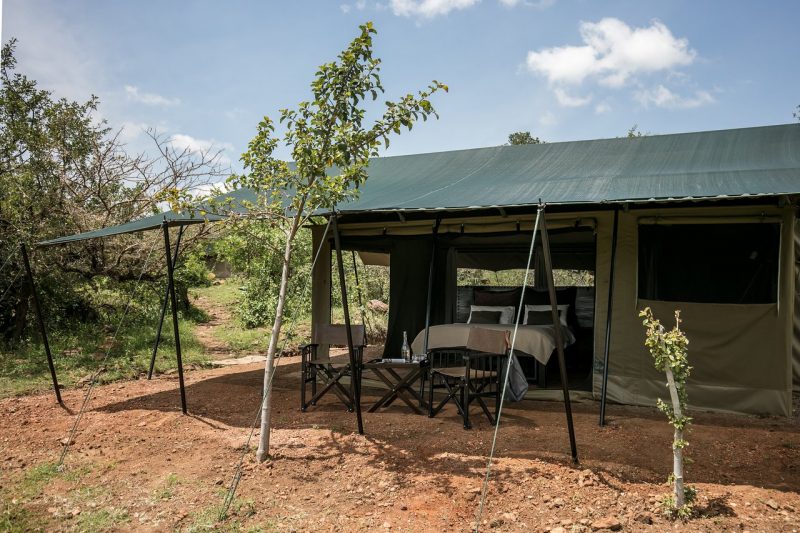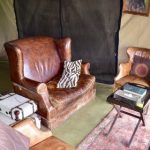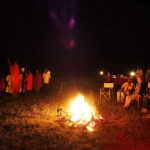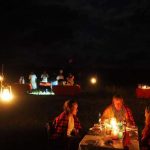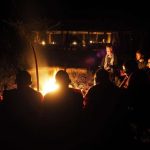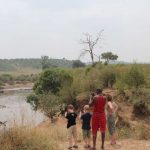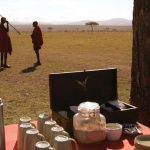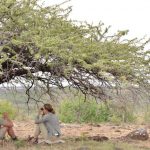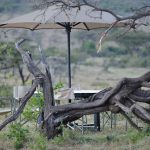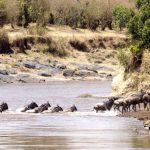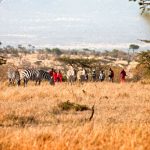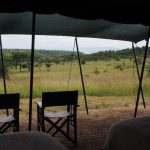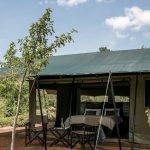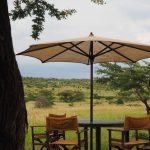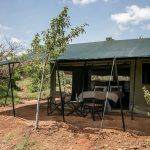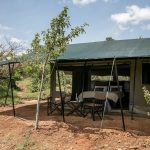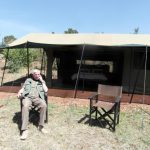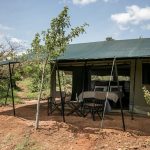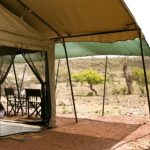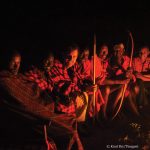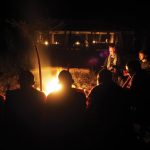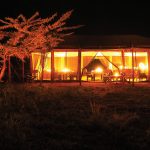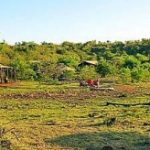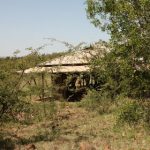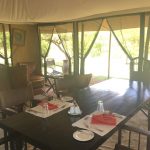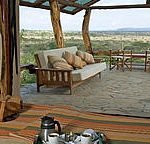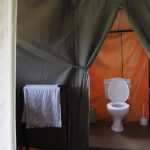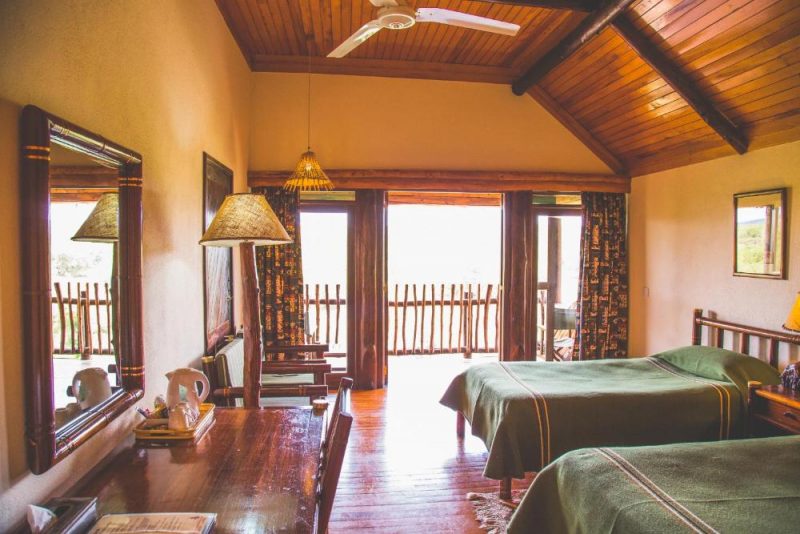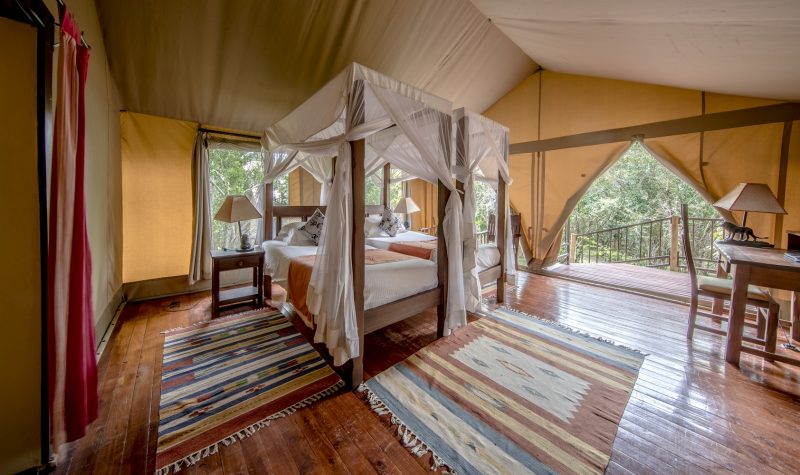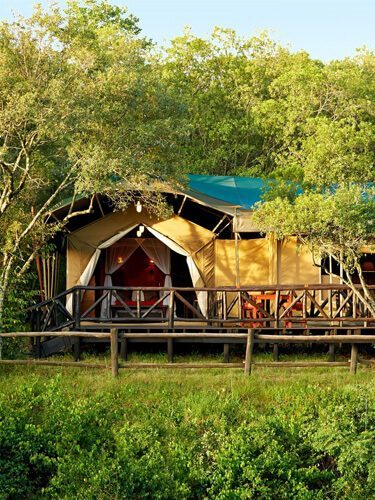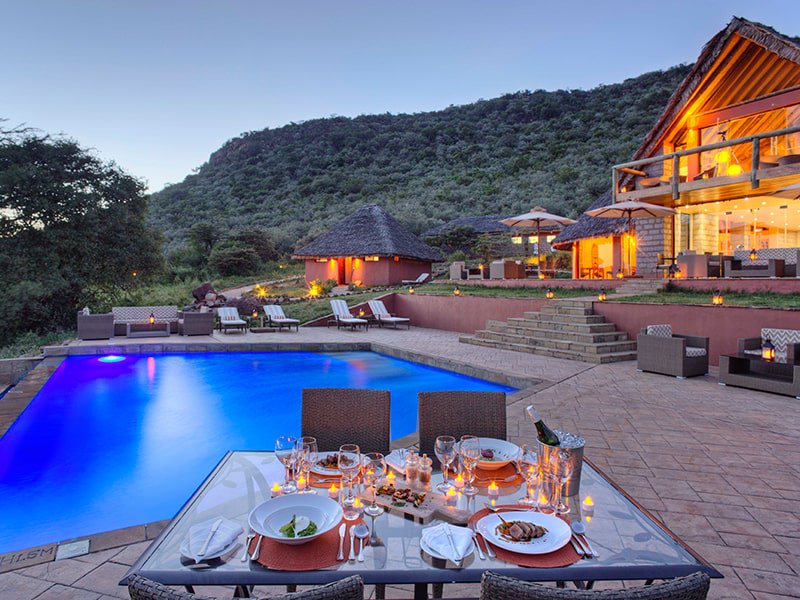Shs. 16,000/- ground package per person per night at Wilderness Camp Mara
Valid until 21 May 2021
Ground packageDouble: Shs. 16,000/- per person per night Single: Shs. 23,000/- per night Includes full-board accommodation, mineral water, return airstrip transfers, day and night game drives, guided walking safaris Not yet open |
Children:0 to 3 years – free 3 to 12 sharing with adults – 50% of adult rate 3 to 12 in own tent – 75% of adult rate 1 adult and 1 child – double + 70% of double |
To book this package please fill out the following form or simply email us on safaris@safari-center.com
Wilderness Camp Mara
Wilderness camp is a tribute to the safaris of the early explorers and safari pioneers. It is free from artificial luxury. Wilderness camp is how safaris were meant to be. Tucked away deep inside the Saddle Valley, it is just you, the Maasai, the wildlife and the stars. From Wilderness, we offer our signature walking safaris. These can be tailor-made to suite your preferences, ranging from short hikes to several days in the bush.
Camp
The 8 tents have been placed around the Saddle valley rim to allow for complete privacy and views of the savannah. The dining tent offers a romantic sitting area with comfortable leather chairs, carefully selected reading materials and a vintage gramophone. Wilderness is a place of enticing contrasts that will bring you closer to nature, and indeed to yourself. Allow yourself to be amazed by the magical ambiance of complete stillness and seclusion; perfectly enjoyed alongside our selection of first-class food and drinks.
Animals of Maasai Mara
The expert guides are always ready to reveal to you the secrets of the savanna. Maasai Mara game reserve is a renowned park that offers wildlife viewing throughout the year. The Maasai Mara plains are dominated by a variety of mammals. From large herds of herbivores which include the wildebeest, zebra and Thompson’s gazelle to the famous Big Five. It is also home to the Nile crocodile. You will spot them sunbathing on the riverbanks, mouths agape, waiting for prey. There are also over 450 species of birds.
Maasai Mara reserve
The Masai Mara is one of the best-known reserves in the whole of Africa. It is renowned for its wildlife. More than 40% of Africa’s larger mammals can be found here. Across the vast plains of the Mara, visitors are able to witness lions, cheetahs, leopards, elephants and other species in their natural habitats.
Landscape
Maasai Mara contains some 25% of what is left of Kenyan wildlife. The estimate says that around 70% of Kenya’s wildlife lives outside national parks and reserves. Thus the need for new role models preserving the Mara wildlife, on private land is paramount. Naboisho plays that role today. Africa has lost some 95-98% of its most iconic mammals over the last 100 year or so, elephants, rhinos, lions, and cheetah. WWF estimate that the world will lose 2/3 of its vertebras in the short period 1970-2020, ie 50 years. Some 70% of the world’s ecosystem is under stress due to loss of habitat.
Location
The Masai Mara lies in the great rift valley, which is a fault line some 3,500 miles long stretching from Ethiopia’s Red Sea through Kenya, Tanzania, Malawi and into Mozambique. Here the valley is wide, and a towering escarpment can be seen in the hazy distance. The animals are at liberty to move outside the park into huge areas known as dispersal areas. There can be as much wildlife roaming outside the park as inside. Many Maasai villages are located in the dispersal areas and they have developed a relationship with the wildlife.
Terrain
There are 4 main types of terrain in Mara – Ngama hills to the east with sandy soil and leafy bushes favoured by black rhino; Oloololo escarpment forming the western boundary and rising to a magnificent plateau; Mara triangle bordering the Mara river with lush grassland and acacia woodlands supporting masses of game, especially migrating wildebeest; and central plains, forming the largest part of the reserve with scattered bushes and boulders on rolling grasslands favoured by the plains game.
Wildlife
The Mara is perhaps best known for the great migration, which takes place every year July to September. During these months the yellow savannah is dotted black by more than 1.5 million wildebeest, zebra and antelopes that migrate from the Serengeti to the Mara in search of food and water. This is where the world’s largest multi-species migration takes place. The movement is centred around the wildebeest migrating from Serengeti into Maasai Mara during the dry period in Tanzania, crossing the mighty Mara river on their way. The great wildebeest migration rightfully deserves its standing as one of the natural world’s most astonishing spectacles.
Migration
From the end of July onwards, millions of freshly arrived brown and black dots scatter the great plains of the Maasai Mara national reserve, making this natural wonder of the world even more wondrous until they wander back in December. The life cycle of the wildebeest is a snapshot of the circle of life of all living creatures. They wildebeest spend their lives wandering. Their migratory routes are determined by the rain patterns; they wander in constant pursuit of water and fresh grass. Similarly, their calving instincts are timed to the movements of the moon, resulting in a three-week-long birth fest on the Serengeti plains in February.
Wildebeest
The comings and goings of the wildebeest also shape the lives of many other species. For the predators of Maasai Mara, the arrival of the wildebeest marks the beginning of a time of feasting and prosperity. The big cats, in particular, thrive during the migration season. The abundance of available prey means that the lions, cheetah and leopards are able to grow strong and produce healthy offspring. The dramatic contrast between life and death can be witnessed during the great migration.
Making the migration even better
No one knows the savannah-like the Masai – these are the true experts. Like the wildebeest, the Maasai people are a nomadic culture who wandered the plains with their cattle. In modern time the Maasai have been forced to find alternative ways of living. We are proud to have been their partners during this struggle to preserve their area.
Community
Experiencing the great migration adds another layer to witnessing this natural wonder of the world. A safari with the Maasai guides is a life-changing experience that will provide you with a deeper, more meaningful understanding of Maasai Mara. Because of our commitment to the Maasai community, we are able to provide authentic safari experiences that leave the guests filled with lifelong memories, a sense of purpose and a longing to participate.
Safari dimensions
The three camps have been designed to offer unique, yet complementary experiences. Our mother-camp, Basecamp Maasai Mara is situated bordering the Maasai Mara National Reserve, making this the ultimate place for welcoming the Great migration as they arrive from the Serengeti. For a different, but equally fantastic experience, our Naboisho Camps – Eagle view and Wilderness bush camp – offer exclusive viewing of the northern migration, the not-so-distant relations of the great migration. Wherever you are in our circuit the Basecamp signature of exclusivity, authenticity and sustainability remain.
Best time to see the migration
The best time to witness the migration from the Serengeti to Masai Mara is between July and September. During this period, the greatest spectacle on earth unfolds right before your eyes. Over a million wildebeest, zebra and gazelles make their way to Maasai Mara by crossing the crocodile-infested Mara river in search of greener pastures. The exact timing may change from year to year as it is a spontaneous event influenced by rainfall patterns and the subsequent grazing opportunities. The animals are constantly on the move all year-round. They stay in the Masai Mara from July to October before gradually migrating back to the Serengeti from November.
Big Five
The Big 5 is a term that is used to refer to the 5 African animals that early big game hunters considered most difficult and dangerous animals to hunt on foot in Africa. These animals include the African elephant, lion, leopard, Cape buffalo, and rhinoceros.
Elephant
This is the largest land animal in the world. Some of the adults can reach up to 3 meters in height. The adult males, bull elephants, are usually solitary creatures while females are generally found in groups led by a matriarch surrounded by younger females and their offspring. Although they are referred by many as gentle giants, elephants can be very dangerous and have been known to charge at vehicles, humans and other animals when they feel threatened.
Lion
The lion is often called the king of the jungle because it is the fiercest and largest predator on land. Lion’s natural prey includes zebras, impalas, giraffes and other herbivores especially the wildebeest. Lions tend to group themselves in pride of 12. Males are easily distinguished from females with their shaggy manes and are generally much larger. The females, however, do most of the hunting. Although they have been known to attack humans, lions are generally calm animals that do not usually seem threatened by close proximity to people.
Leopard
Unlike the lions, leopards are almost always found alone. They are the most elusive of the big five since they mostly hunt during the night. The best time to find them is very early in the morning or at night. During the day you need to look carefully for these animals who usually can be found partially camouflaged in the undergrowth or behind a tree.
Buffalo
The buffalo is perhaps the most dangerous to humans among the big five. Buffalos are very protective and territorial and when threatened they are known to charge with astonishing speed. The buffalo are mostly found in groups and large herds. They spend most of their times grazing the savanna and floodplains. When approached the dominant bulls will tend to take an aggressive vigilant stand while the other adults gather around the calves to protect them.
Rhino
Rhinoceros are an endangered species. Even seeing one at a distance is a rare treat. There are two types of rhinos: the black and white rhinos. The white rhino gets its name not from its colour which is really more yellowish grey but from the Dutch word weid which means wide. This is in reference to the animal’s broad, wide mouth. With its square jaw and wide lips, they are able to graze. The black rhino, on the other hand, has a more pointed mouth which it uses to eat leaves from trees and bushes. White rhinos are much larger than the black rhinos and more common.
Bird walk
Bird walking is an adventurous safari that involves observing and studying different species of birds, in their natural habitat. This adventure is conducted with the help of our passionate birding specialist Masai guide. Together with your guide, this excursion will help you know how to recognise and name bird species by sight, sound and habitat. Bird walking safari is one of the main activities here, which is located along the Talek River. Basecamp Masaai Mara is surrounded by a wealth of diverse flora and fauna. The afforestation program has since attracted over 300 bird species that have been recorded in the Maasai Mara, including the endemic birds and the other wildlife species that it possesses. The atmosphere at the camp offers excellent opportunity to view the birds in their natural habitat, with good photographic opportunities.
Cameras
You can charge your camera, video recorder and phones at Basecamp Maasai Mara, Eagle View, Wilderness camp and Leopard hill but sometimes the power can be a bit restricted so check upon arrival when is the best time for charging. When selecting camera equipment, remember that there can be quite a lot of dust on the game safaris, so it is best to have good cover for your gear. Equipment for cleaning your lenses is also a smart choice.
Cultural walk
Our cultural walk is conducted in Talek town led by expert Maasai Guides. Talek is situated just outside of the Masai Mara Reserve and within a 10-minute walk from our Basecamp Maasai Mara camp. Enjoy a unique opportunity to learn about the rich cultural heritage of the Maasai as well as the challenges they face. The tour takes approximately 1- 2 hours. You will begin your visit with a tour around Talek Primary School then head off to the Talek Health Center finishing off your cultural tour with a visit to the waste management area. This is an ideal trip for travelers wanting to get to grips with not only the wildlife but the culture and wonderful people of Masai Mara.
Talek primary school
For years, very few Masai people received any formal education. Primary schools were a rare sighting and secondary schools were virtually non-existent. But thanks to partners like Basecamp, more Maasai children than ever before are enrolled in schools. Supported by Basecamp Explorer, Talek Boarding School has about 500-day scholars from the neighboring villages, as well as another 500 boarders who live too far away to walk to school every day. Your Maasai guide will take you over to the school and explain how the school works. The school provides the children with an opportunity to access education giving them a chance for a better future.
Talek community health centre
The Talek community health centre provides medical service to a majority of the people living near Masai Mara National Reserve. Together with other partners, we have supported the development of infrastructure and the much-needed resources at the health centre which addresses the challenges of late diagnosis associated with walking long distances to reach clinics and reduce mortality from curable illnesses like malaria.
Waste management program
As a responsible tourism operator, Basecamp Explorer cares about the communities surrounding our camps. Not only do we sort the solid waste produced at our camps through our operations, but also extend our waste collection, management, and recycling program to benefit the local communities. With this effort, we empower the Maasai people by building much-needed capacity to facilitate the sustainable development of the communities.
Dress code
At Masai Mara the dress code is fairly informal; just pick the clothes that you are most comfortable in. In Masai Mara you are at about 1300-1500 meters above sea level, so nights can be a bit chilly. Bring your sweater or fleece jacket and wind or raincoat as well. Morning and evening game drives can also be quite cold. The savannah is dusty, so white clothes are not advisable. Sandals are fine within the camp, but gym shoes – preferable with a solid sole – or hiking boots are important for walking safaris. Bring a small backpack to carry your water bottles, notebooks, binoculars etc. If you are visiting the coast we strongly encourage you to carry clothing that covers the shoulders and knees, out of respect for the locals’ religion and culture. When you are on the beach or at the Dhow, bikinis or bathing suits are fine.
How to get to Maasai Mara
There are two ways to get to the Maasai Mara. This can either be by road or by flight. Whichever method you want to use will be determined by your comfort.
Flights to Mara
Flying is the quickest way to get to Mara. There are daily flights to the Mara from Wilson Airport provided by companies such as SafariLink and Air Kenya. A flight to Mara takes around 45 minutes. On arrival, the aircraft will land on an airstrip nearest to your camp. Basecamp guests are usually picked up from Olseki or Olkiombo airstrips. From there, guests will be transferred by road to their particular camp.
Drive to Mara
Maasai Mara is about 280 km. west from Nairobi City. A drive to Masai Mara takes about 5-6 hours. While driving you will enjoy breathtaking views including that of the Great Rift Valley and also Mount Suswa and Mount Longonot. The road from Narok to the reserve is quite rough and it is advisable to use a 4×4 vehicle as this will make your ride a bit smoother. Once you get to Maasai Mara there are a number of entry gates such as Sand River, Musiara, Talek, Sekenani or Oloololo gate.
Maasai community visits
A community visit is a cultural tour where guests have an opportunity to meet local people and enjoying the cross-cultural interaction. We are committed to ensuring all of our guests return home from their trip with a real sense of the places they visited. The main activity during a community visit is a guided community walk during which you will check out the different interesting sites that our local Masai guide will suggest. The guide will give you all the information you may need to know about the places you will visit. During the community walk, you visit places like the local schools, health centres, homesteads as well as the market. In addition, you’ll learn about ancient traditions as well as contemporary struggles and adaptations to modern life.
Talek open market
Wednesday is market day in Talek, people come from far and wide to buy and sell their products and livestock. Enhance your safari experience with a Market visit when it coincides with your trip. Talek Market days are full of life with Maasai women dressed in their very best; red and blue dresses paired up with pretty jewellery around the forehead, neck, arms, and ankles trying to sell their goods to willing customers. Enjoy the vibrant atmosphere of the colourful market as you stroll around and observe the traditional way of trading. Most of the products at the market express the rich cultural and creative heritage of Africa and the Maasais in particular. From unique trinkets to a variety of colourful textiles and other collectibles.

